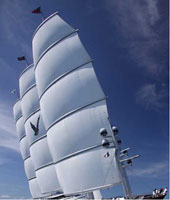 Arthur Sewall, a shipbuilder, shipowner and industrialist from Bath Maine, is quoted near the turn of the 20th century, saying, “As long as the wind blows and water flows there will be sailing ships built and business to keep them busy.” Is the great age of commercial sail now just part of history, or are we merely passing through a short-lived era of fossil fuels, which will be brought to a close by scarcity and concerns about pollution and climate change?
Arthur Sewall, a shipbuilder, shipowner and industrialist from Bath Maine, is quoted near the turn of the 20th century, saying, “As long as the wind blows and water flows there will be sailing ships built and business to keep them busy.” Is the great age of commercial sail now just part of history, or are we merely passing through a short-lived era of fossil fuels, which will be brought to a close by scarcity and concerns about pollution and climate change?
This question was brought to mind by a series of articles last month (see also here and here) about the sailing ship design being developed by B9 Shipping. In many respects the information in the articles is not new. We posted about the B9 Project in October of 2010. Nevertheless, new publicity for the modern sailing ship design is all for the good.
The B9 design is a modern 3,000 DWT sailing ship with three rotating masts, square sails and automated sail handling. The B9 design is currently undergoing testing at the University of Southampton’s Wolfson Unit for Marine Technology and Industrial Aerodynamics (WUMTIA). B9 anticipates the vessel will derive 60% of its propulsive power from the wind. The remainder will be provided by an auxiliary engine burning bio-fuels.
The design of the rig is similar to that of the Maltese Falcon, a yacht built in 2006 for an American venture capitalist. The rig design is based on the DynaShip / Dyna-Rig design developed by the German naval architect William Prölss in the 1960s. The Dyna-Rig has several advantages. It is far more aerodynamically efficient than traditional sailing rigs and can be operated with a smaller crew. Also, as the Maltese Faclon has been sailing for for six years, the design has been proven in operation. The Dyna-Rig’s primary disadvantage is that the free standing rotating masts are expensive to build. The Maltese Falcon‘s are fabricated from carbon fiber. The internal rigging, winches and sails could also be expensive to maintain on a commercial basis. The masts could also interfere with cargo operations.
While the recent articles focused on the BP Shipping design, Fairtransport, which operates the traditional brigantine “Tres Hombres,” is also developing a Dyna-Rig based ship design. Their Ecoliner is an 8,000 DWT four masted modern square rigged ship designed by the naval architecture firm, Dykstra & Partners, which also designed the Maltese Falcon.
Thanks to Irwin Bryan for contributing to the post.

i’ll never forget the time last summer maltese falcon sailed south from chelsea piers, blew past the Statue topping 15 kts with all sail set, and before they reached sunset park, had doused all sail with touch of a button. will some coastwise cargo vessels do this with dyna-rigs by midcentury?
Pingback: The Return of Commercial Sail – UT Wind Challenger & Retracting Rigid Wing Sails | Old Salt Blog – a virtual port of call for all those who love the sea